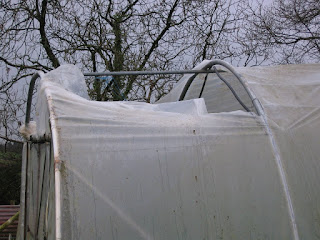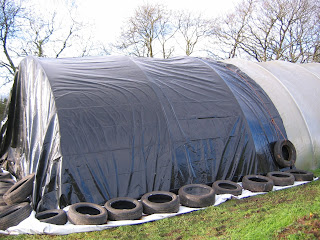Mechanised seeders tend to be expensive but, if you have a lot of seed to sow, they begin to make sense. Certainly, we have been impressed with the simple aluminium
EarthWay Seeder which we have used since 1998, and it continues to be a popular item in our 'Online ToolShop'.
Then, last year, we started to sell the (much cheaper)
SAALET Easy Sower from Denmark. Made of plastic instead of aluminium, it is obviously less robust, but we had been encouraged by Eliot Coleman's comments in his book
The New Organic Grower : "Another seeder option I have found useful in the greenhouse is the SAALET or "So Easy Super Seeder" made in Denmark. This is a small plastic unit for home gardeners with seed plates that adapt to most seed sizes and spacing requirements. It is inexpensive and built well enough that I use it commercially. I have a number of them permanently set up with different seed plates for the seed sizes I use. The only modification I have made is to replace the cheap plastic handle with a wooden one." (Chapter 23 - The Winter Garden).
We have not really tested ours thoroughly enough yet to be able to offer our own feedback, but we have had one largely negative review from Justin in New England and one very brief but fairly positive one from Neil in London.
Here Justin's complete review (including some American spelling!):
"Review of the Saalet Sower/Easy Seeder
"I was not compensated in any way for this review.
"Task:
Plant assorted vegetable seeds in a roughly 1000 square foot garden.
Purpose: Conduct planting faster, with less waste, and more even
spacing.
"Arrival and assembly: The seeder arrived in a single
small box, and went together with ease. There are only a couple of
metal components on the seeder which consist of a of nuts and bolts,
everything else is high density rigid plastic.
"Initial
impressions: I removed the furrower/depth gauge and ran it on a carpet
with some peas. It placed them as expected evenly and simply. I like
the fact that the disks store in one of the wheels, however if they are
not placed in a specific order they rattle while the tool is in use.
The handle is too short for most adults. I will be replacing mine with a
wooden dowel of appropriate length.
"Use: I began by preparing
the garden with the tractor plow, then the rototiller followed by a
rake to make smooth rows. If you are planning on gardening in kitty litter
or sawdust the Saalet seeder will work perfectly. If you plan on
gardening in dirt specifically good dirt with pieces of organic
material, suitable moisture, and possibly a few small aggregate minerals
(rocks) this thing won't work at all in any way. For some reason the
peas were jamming the disk, the wheels were still turning and it would
pop over the engagement point on the jammed disk. With seeds other than
peas it was also hit or miss for spacing due to other problems
mentioned next. The furrower will not cut through soil with bits of
anything in it, material will start to pile up in front of the
furrower. The original handle starts to flex badly when the furrower is
set lower than the top setting. All of these complications result in
this machine, that requires perfect conditions, to work inconsistently
if at all.
"Durability: Before the seeder even saw use in the
garden it fell from storage in my barn, about 5 feet. It was fully
assembled and broke in several places. I was able to bring it back to
fully functional with several zip ties and some epoxy. This
is not a durable tool. I wish that the body and wheels were cast out
of aluminum or steel, it would be indestructible at that point and it
would have the heft to make it functional in a wider variety of soil
conditions.
"Conclusions: This seeder fails to meet any of
the requirements in my initial task and purpose statement. If I could
ask for a refund I would. There is a reason why there have never been
many seeders on the market and why the classic ones demand such a high
price. I plan to look for an old Planet Junior made of metal that will
still function when my son gives it to his grandson."
Thanks, Justin, but it is pretty negative! To be fair, the manufacturer's
'User Manual' leaflet states very clearly "The Easy Sower can only sow directly in
well prepared soil." We emphasise the same point on
our website by saying:
"We have only just started trialling our own Easy Sower but here are some initial tips:-
"1) Don’t expect too much of it! If your soil is hard, heavy or lumpy, the Easy Sower will not be able to make a neat furrow. Consider getting the soil to a finer tilth before sowing, or make the furrow with a hoe or rake before using the seeder.
"2) In the same way, wet muddy soil will tend to clog up the Easy Sower - and is hardly ideal for seed sowing, anyway!"
Our friend Neil has also tried his hand at the SAALET and his comments are brief and to the point: "I used the seeder the other day and I can see why the others suggested
the use of a broom handle. The plastic handle flexes as you push the
seeder and therefore does not give a constant rotation and feels flimsy." He hasn't made any other comment!
In summary, it seems that, so far, everyone agrees that it is worth fitting a wooden broom handle and it looks like that should help to reduce at least some of the problems that Justin listed. His other battles mainly seem to relate to the difficulty of pushing this lightweight machine through heavy soil. As we also have heavy soil, we can sympathise. Eliot uses his SAALETs in his greenhouses/polytunnels but is convinced enough to go on using them. Obviously, soil conditions are a little more controllable inside a greenhouse and I think Eliot's soil tends to be lighter and sandier than ours but, all the same, he is a professional grower and needs kit that will work for him and earn its keep!
We will go on trying ours out and let you know how we get on. How about you? Do please
email us if you have some feedback to share on this or any other of the tools we sell. We will be happy to publish your comments on this blog – with your permission, of course.


















